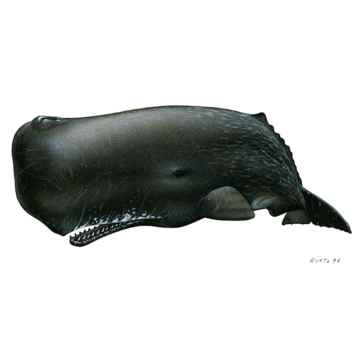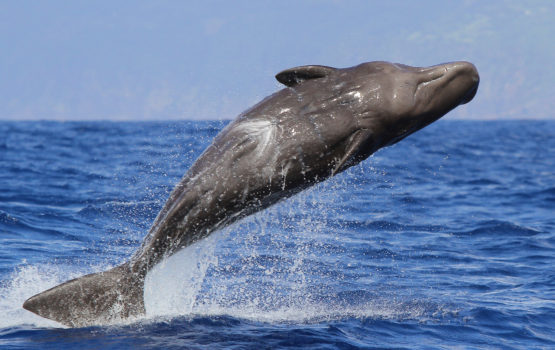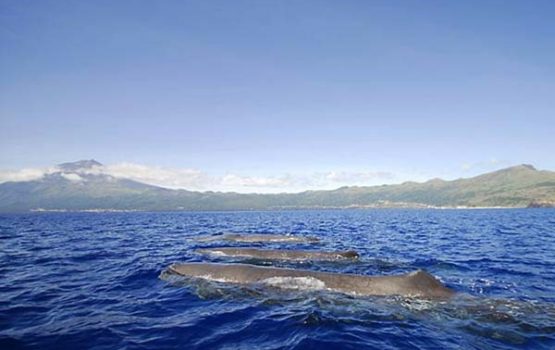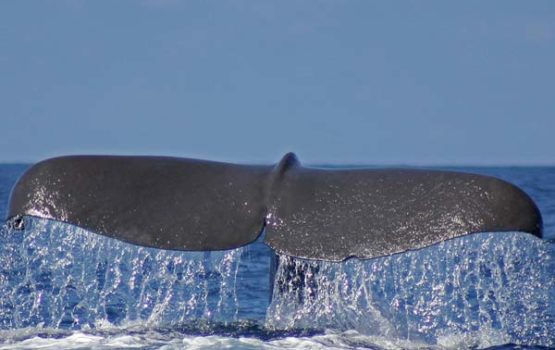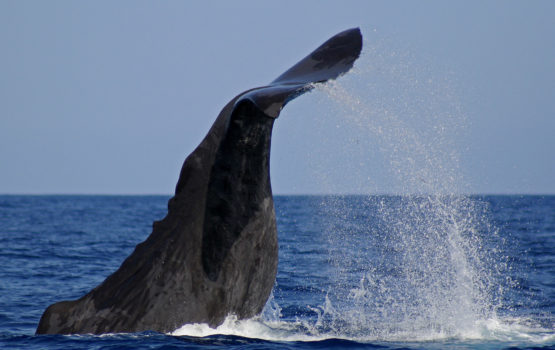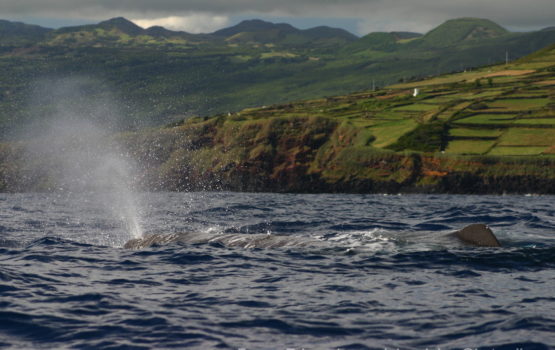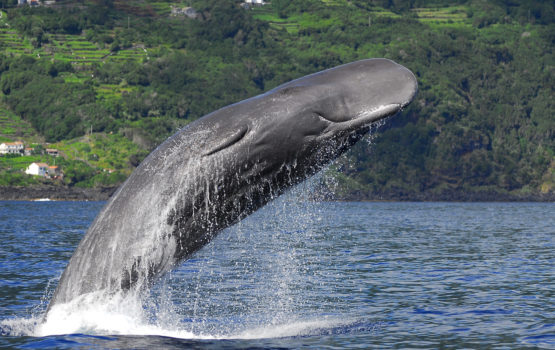Sperm whales are the largest toothed whales, with a pronounced sexual dimorphism. The males can reach more than 18m in length and more than 55tonnes of weight, while females usually don’t grow to more than 12m and weights of 20tonnes. Newborns are 4m long and weigh about 1000kg. There are 18-26 pairs of large conical teeth along the lower jaw. Life span of this species is, at least, 70years.
Sperm whales have disproportionally large heads, up to one-third of their total body length, especially males. The colouration is dark grey but may appear brown in bright light. The area around the lower jaw becomes whiter with age and there are often irregular whitish spots on their bodies. The skin of the head is smoother than the rest of the body, which usually has a wrinkled aspect. The lower jaw is narrow and barely viewed from the side. The blowhole is set forward on the head and skewed strongly to the left, so the blow is also projected forward and to the left. The dorsal fin is low, wide and round in shape. The ridge along the back behind the fin is lined with bumps, and the caudal peduncle is thick. The flukes are triangular with a straight trailing edge.
The main food items of sperm whales are large and medium-sized squid, and other cephalopods. Stomach contents of adult male sperm whales seem to show that fish also takes a considerable part of their diets. Female sperm whales live in stable, long-term groups, which vary in size between 8-20 individuals per group. Males begin leaving the family groups as early as 10years old, forming young adult males associations. The cohesion of these groups weakens with time, and adult males are very often solitary. Young adult females give birth once every five years, after a gestation period of about 15-16months; for older females the calving interval is longer. Breeding grounds are in tropical and subtropical waters where females are present, but birth can occur at any season. The majority of their time is spent foraging, and these animals dive deep and long to search for food. Typical female sperm whale’s dives are about 40-50min long and 600-800m deep, followed by periods of 10min at the surface resting. Before a dive, all age classes arch their backs, and adults as well as juveniles, always raise their flukes when diving. When socializing the entire group can be seen at the surface, logging parallel to each other or even breaching, and tail slapping.
Sperm whales have disproportionally large heads, up to one-third of their total body length, especially males. The colouration is dark grey but may appear brown in bright light. The area around the lower jaw becomes whiter with age and there are often irregular whitish spots on their bodies. The skin of the head is smoother than the rest of the body, which usually has a wrinkled aspect. The lower jaw is narrow and barely viewed from the side. The blowhole is set forward on the head and skewed strongly to the left, so the blow is also projected forward and to the left. The dorsal fin is low, wide and round in shape. The ridge along the back behind the fin is lined with bumps, and the caudal peduncle is thick. The flukes are triangular with a straight trailing edge.
The main food items of sperm whales are large and medium-sized squid, and other cephalopods. Stomach contents of adult male sperm whales seem to show that fish also takes a considerable part of their diets. Female sperm whales live in stable, long-term groups, which vary in size between 8-20 individuals per group. Males begin leaving the family groups as early as 10years old, forming young adult males associations. The cohesion of these groups weakens with time, and adult males are very often solitary. Young adult females give birth once every five years, after a gestation period of about 15-16months; for older females the calving interval is longer. Breeding grounds are in tropical and subtropical waters where females are present, but birth can occur at any season. The majority of their time is spent foraging, and these animals dive deep and long to search for food. Typical female sperm whale’s dives are about 40-50min long and 600-800m deep, followed by periods of 10min at the surface resting. Before a dive, all age classes arch their backs, and adults as well as juveniles, always raise their flukes when diving. When socializing the entire group can be seen at the surface, logging parallel to each other or even breaching, and tail slapping.
The habitat of sperm whales is cosmopolitan, with a marked difference between the females and juvenile’s home ranges and the adult male’s foraging grounds. Only adult males move into higher latitudes for feeding, and they can be seen in cold, polar waters. Females and immature males range throughout tropical and temperate waters, generally remaining for periods of decades in the same areas, making them locally resident. The size, body shape, very small dorsal fin, and forward-left-orientated blow of sperm whales makes them easy to identify at sea. However, because the blowhole of northern bottlenose whales (Hyperoodon ampullatus) is creased, their blows are also often, forward projected. The large and tall dorsal fin of northern bottlenose whales, opposed to the small and round one of sperm whales should help the recognition of the species.
Sperm whales are the only resident species of whales in the Azores and they are observed by the Espaço Talassa team from March to November, but records from whaling times indicate that they are present in the winter as well. There are subtle fluctuations on the sightings of this species with some years better than others, but on average they are present on 60% of our trips. Although seen annually, there is a peak in the observations of this species in the summer months with July being the best month to come to the Azores to see this great whale.
Sperm whales are the only resident species of whales in the Azores and they are observed by the Espaço Talassa team from March to November, but records from whaling times indicate that they are present in the winter as well. There are subtle fluctuations on the sightings of this species with some years better than others, but on average they are present on 60% of our trips. Although seen annually, there is a peak in the observations of this species in the summer months with July being the best month to come to the Azores to see this great whale.
PT: Cachalote / AZORES: Baleia
ENG: Sperm whale
FR: Cachalot
DE: Pottwal
IT: Capodoglio
ESP: Cachalote
NL: Potvis
ENG: Sperm whale
FR: Cachalot
DE: Pottwal
IT: Capodoglio
ESP: Cachalote
NL: Potvis
